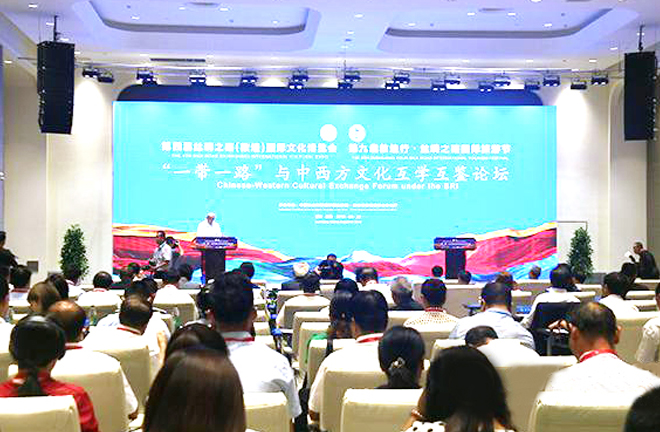Belt and Road propels cultural exchanges

More than 150 experts attend the recent “Chinese-Western Cultural Exchange Forum Under the BRI” in Dunhuang, Gansu Province. Photo: GSTV
At the recent “Chinese-Western Cultural Exchange Forum Under the BRI” held in Dunhuang, Gansu Province, more than 150 experts from both home and abroad discussed how the Belt and Road (B&R) can promote cultural exchanges and mutual learning.
The Chinese nation began conducting cultural exchanges thousands of years ago. Through the ancient Silk Road, the Four Great Inventions of ancient China—papermaking, printing, gunpowder and the compass—along with sericulture technology, silk, porcelain and ironware were introduced to the rest of the world. At the same time, Buddhism, Islam, and Arab astronomy, calendars and medicine, as well as exotic species such as the pepper and grape, were introduced to China.
Ouyang Jian, chairman of the Chinese People’s Political Consultative Conference Gansu Provincial Committee, said in his speech that Dunhuang is a model for mutual learning and integration between Chinese and Western cultures.
Cai Fang, vice president of the Chinese Academy of Social Sciences (CASS), said that the ancient Silk Road opened an era of extensive communication among civilizations. Natural explorers and cultural investigators who had travelled along the ancient Silk Road turned it into a road of knowledge exchange and mutual learning.
In today’s era of globalization, we should pick up and carry forward the spirit of the ancient Silk Road, strengthen the cultural exchanges along the Silk Road, and build a platform for people-to-people exchange, Cai suggested.
CASS Member Chao Gejin said that in the construction of the B&R, China upholds the principles of extensive consultation, joint contribution and shared benefits, which provides a Chinese formula for current global governance. The B&R initiative is playing an increasingly positive demonstrative role in breaking through regional obstacles, communicating with the world and promoting peace.
Wang Xudong, curator of the Palace Museum, said that as world-renowned cultural heritage, both the Dunhuang Grottoes and the Forbidden City were created by people with an open mind. Both the Palace Museum and the Dunhuang Academy China must similarly keep an open mind and look beyond Dunhuang and the Forbidden City for further study. Both should support academic research, be driven by social demand, excavate the value of cultural relics, and facilitate the transmission and prosperity of Chinese culture.
Today, we need to transcend cultural boundaries with civilizational exchanges, address cultural conflicts with mutual trust, and overcome cultural bias through the co-existence of cultures, thus promoting the mutual respect and inclusive development of different cultures and contributing to the building of a community of shared future for mankind, Ouyang suggested.
edited by JIANG HONG
